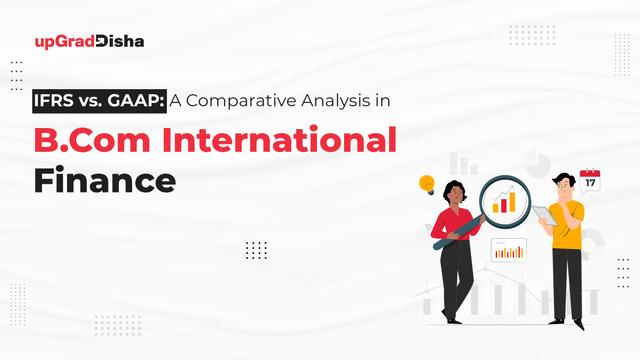IFRS vs. GAAP: A Comparative Analysis in B.Com International Finance
February 26th, 2024: 5 mins
|
This Article Explores:
|
The International Financial Reporting Standards (IFRS) and the Generally Accepted Accounting Principles (GAAP) are two of the world's most frequently utilized accounting standards. They are used to generate financial reports and verify that the information presented is valid and comparable. The major differences between IFRS and GAAP are extensive and involve topics like recognition, measurement, and presentation, as well as disclosure-based areas such as segment reporting.
As of 2024, Swiss Re has projected an IFRS net income of more than USD 3.6 billion for the year, complementing a multi-year Return on Equity (ROE) objective of better than 14%. Additionally, the International Financial Reporting Standards (IFRS) S1 General Requirements for Disclosure of Sustainability-related Financial Information become effective for annual reporting periods starting on or after January 1, 2024.
Studying B.Com International Finance Reporting practices and procedures can help students grasp such global accounting standards. Follow this blog for more insights.
IFRS vs. GAAP Comparison
A detailed International Financial Reporting Standards vs. Generally Accepted Accounting Principles comparative study is presented in the table below:
|
Area |
GAAP |
IFRS |
|
Primary Purpose |
Rule-based |
Principle-based |
|
Adopted Countries |
United States |
More than 144 countries worldwide |
|
Regulatory Body |
Financial Accounting Standards Board (FASB) |
International Accounting Standards Board (IASB) |
|
Treatment of R&D Expenses |
Booked as incurred |
Capitalize certain internal costs like prototypes |
|
Inventory Valuation Methods |
FIFO, Weighted Average, Specific Identification, LIFO |
FIFO, Weighted Average, Specific Identification |
|
LIFO Inventory Method |
Allowed |
Not allowed |
|
Inventory Write-Down Reversals |
Prohibited |
Permitted if market value increases |
|
Revenue Recognition |
Based on contract terms |
Based on the transfer of control principle |
|
Impairment Loss Reversals |
Not Allowed |
Permitted if conditions are met |
|
Financial Statement Presentation |
|
|
|
Disclosures and Terminology |
Less detailed |
More detailed |
|
Lease Accounting |
Lessee recognizes lease payments as rent expense |
Lessee recognizes a right-of-use asset and related lease liability |
|
Intangible Asset Treatment |
|
|
|
Financial Instruments |
Classifies based on substance and economic reality |
Utilizes complex classification and measurement |
IFRS and GAAP Convergence Trends
IFRS vs. GAAP implementation challenges provide substantial barriers for multinational organizations struggling with the convergence of the two accounting standards. The push to negate the gap between GAAP and IFRS emerges from globalization, the Sarbanes-Oxley Act (SOX), and the Securities and Exchange Commission's (SEC) acceptance of international standards.
The convergence and subsequent adoption of accounting and reporting standards at the international level affect business management, investors, the stock markets, accounting professionals, and the regulatory bodies for accounting standards. A major issue in the process of the change from IFRS to GAAP is the difference in accounting methods of these two standards, which causes large revisions during the switchover period, which then poses a big problem for financial reporting uniformity across borders.
Businesses face many technological challenges when it comes to the convergence of two frameworks simultaneously, e.g., understanding the new standards, adapting the old system, and staff training on new methods. Notwithstanding the issues of merging IFRS with GAAP, some of the organizations have succeeded in this process, reflecting that proper planning and management can help tackle such obstacles.
Mastering the IFRS vs. GAAP Comparison in the Online B.Com International Finance and Accounting Program

Online B.Com degrees, with specialization in International Finance, focus on disciplines such as accounting, financial analysis, and international finance. It is designed to help students pursue careers as wealth builders and managers in corporate and merchant banking, with a strong emphasis on ethical conduct and a complete awareness of international regulations and financial reporting requirements.
The curriculum is linked with the ACCA (Association of Chartered Certified Accountants) accreditation, giving students a competitive advantage to pursue a career in international finance and accountancy.
Offered under the guidance of leading institutions, such as Jain University, this program offers in-demand coursework, equipping students with industry-relevant knowledge to future-proof their careers!
The curriculum covers a wide range of topics, including financial accounting, management accounting, international finance, business economics, financial modeling, taxes, auditing, and corporate and business law, among other subjects. Under such a comprehensive curriculum, students also get the chance to explore the global financial system, international commerce, and foreign currency markets to help them master the topic of IFRS vs. GAAP comparison.
Final Thoughts
B.Com International Finance comparative analysis of IFRS and GAAP helps students comprehend the technicalities of both standards, helping them understand how to operate in cross-border corporate operations, mergers and acquisitions, and investment analysis.
We hope the provided comparative analysis of the two primary accounting systems will help students develop informed opinions and expand their skills in terms of financial data and its results.
If you’re further interested in programs that can strengthen your financial acumen, explore upGrad Disha. Delve deeper into a catalog of finance programs and explore their potential to take your career ahead!
